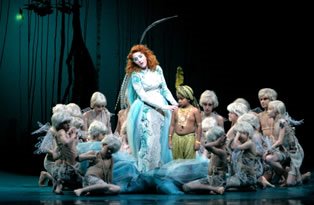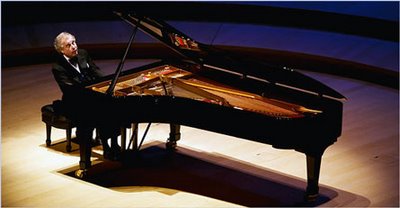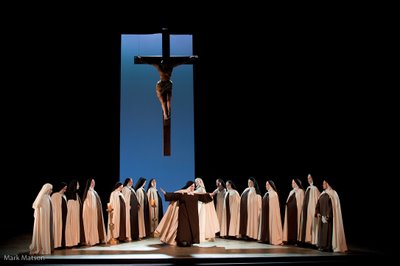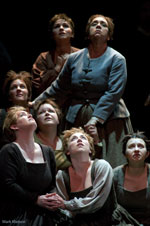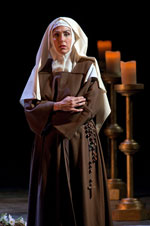[Version française ci-dessous]
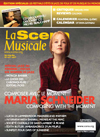 Editorial
Editorial
Last month, I attended the 11th Annual Vanier College Big Band Benefit, dedicated, this year, to the Women of Vanier. The rousing performance by the young ensemble directed by Jocelyn Couture was recorded by CBC Radio Two for Music Monday, an annual demonstration of love of music in elementary and secondary schools, to be held this year on May 4, 2009. Last year over 700,000 youths took part, boding well for the future of music. As I was watching the stage, I was surprised by the all-female trumpet section, and I felt encouraged by the changing times; when I played in high school, all the trumpeters were boys. How coincidental then that our May issue focuses on Women in Jazz, meeting Jazz composer and bandleader Maria Schneider and singer/pianist Patricia Barber.
For the thirteenth straight year, La Scena Musicale, Canada's most wide-reaching and well-respected classical music and jazz magazine, will once again celebrate the summer season in music. This year, our work seems more important, in view of the economic crisis and how much festivals contribute to local economies. The $100 million in federal funds for festivals is welcome, and we hope they are given fairly and used wisely.
This month, we feature our annual national focus on over 130 Canadian jazz, world and folk music festivals (plus several spring classical music festivals). Next month, our June national issue will be dedicated to over 90 classical music and Canadian arts festivals.
Also, in this issue: The St. Lambert Choral Society celebrates 90 years while the Guarneri Quartet retires after 45 years of music making. We provide you with a behind-the-scenes look into the 2009 Edition of the Montreal International Music Competition (Voice) with an interview with baritone Sherrill Milnes. We also meet international soprano Sondra Radvanovsky.
The May Discovery CD features composer Francesco Tárrega’s (1852-1909) works for guitar, presented by Canadian guitarist Michel Beauchamp. Remember that this CD (a collaboration with XXI Records) is free for paying copies of La Scena Musicale. As we continue our 2009 Subscription Campaign, I am pleased to announce that the Canadian music recording industry is lending its support with prizes for a Super Subscription Contest. So far, we have $20,000 in prizes: XXI Records will contribute a collection of 260 CDs, SRI Distribution 200 CDs, Analekta 200 CDs, ATMA 200 CDs, Naxos 200 CDs and CBC Records 100 CDs. What better way to start or complete your CD collection? This contest is open to current and new subscribers as of August 15, 2009.
Lucia di Lammermoor is next on Opéra de Montréal’s bill, and we provide a musicological view of Donizetti’s masterpiece. Lucia is also part of our next fundraising event: Opera weekend in Montreal on May 23rd – an ideal Mother’s Day gift. Call 514-948-2520 for tickets and more information. Download the PDF version.
Wah Keung Chan
Founding Editor/Publisher,
La Scena Musicale
---
 Éditorial
Éditorial
Le mois dernier, j’ai assisté au xie Concert-bénéfice Big band du collège Vanier, dédié cette année aux femmes de Vanier. La prestation enthousiaste du jeune ensemble dirigé par Jocelyn Couture a été enregistrée par CBC Radio Two pour Lundi en musique, une célébration annuelle de l’amour de la musique dans les écoles primaires et secondaires, qui se tiendra le 4 mai en 2009. L’an dernier, plus de 700 000 jeunes y ont pris part, ce qui augure bien pour l’avenir de la musique. Et alors que je regardais les musiciens, j’ai été étonné de voir une section de trompettes entièrement féminine. J’ai été encouragé par cette nouveauté : lorsque je jouais au secondaire, tous les trompettistes étaient des garçons. Quel heureux hasard que notre numéro de mai souligne la présence des femmes dans le jazz : en effet, nous interviewons la compositrice et chef d’orchestre Maria Schneider et la pianiste et chanteuse Patricia Barber.
Pour la treizième année consécutive, La Scena Musicale, le magazine de musique classique et de jazz le plus lu au Canada et respecté dans le monde entier, célébrera de nouveau l’été en musique. Cette année, notre travail revêt une pertinence particulière, en raison de la crise économique et de l’importante contribution des festivals aux économies locales. Les 100 millions de dollars d’aide fédérale accordée aux festivals sont les bienvenus et nous espérons que les fonds seront distribués équitablement et utilisés de façon judicieuse.
Comme chaque année, en mai nous mettons l’accent sur les plus de 130 festivals d’été canadiens de jazz, de musiques du monde et de musique folklorique – sans compter de nombreux festivals de printemps de musique classique. Le mois prochain, le numéro national de juin sera consacré aux plus de 90 festivals d’été de musique classique et d’art au Canada.
Également dans ce numéro : la Société chorale de Saint-Lambert célèbre ses 90 ans et le célèbre Quatuor Guarneri prend sa retraite après 45 ans d’existence. Nous vous amenons dans les coulisses de l’édition 2009 du Concours Musical International de Montréal (chant) dans une entrevue avec le baryton Sherrill Milnes. Enfin, nous rencontrons la soprano Sondra Radvanovsky.
Le CD Découverte de mai est consacré aux œuvres pour guitare de Francesco Tárrega (1852-1909), interprétées par le guitariste Michel Beauchamp. Ce CD (une collaboration avec les Disques XXI) est offert gratuitement à tous les lecteurs qui achètent La Scena Musicale. Nous poursuivons notre campagne d’abonnement 2009 et je suis particulièrement heureux d’annoncer que l’industrie canadienne du disque apporte un soutien généreux à notre grand concours d’abonnement. Jusqu’ici, nous avons 20 000 $ de prix à offrir : les Disques XXI offrent une collection de 260 CD, SRI Distribution 200 CD, Analekta 200 CD, ATMA 200 CD, Naxos 200 CD et les Disques SRC 100 CD. Quelle meilleure façon de commencer ou d’arrondir votre collection de musique ? Ce concours est ouvert aux abonnés existants et nouveaux en date du 15 août 2009.
Lucia di Lammermoor sera la prochaine production de l’Opéra de Montréal et nous publions une analyse musicologique du chef-d’œuvre de Donizetti. Lucia sera également notre prochaine activité de collecte de fonds, un week-end d’opéra à Montréal le 23 mai – un cadeau idéal pour la fête des Mères. Appeler au 514-948-2520 pour des billets ou plus d’information.
Téléchargez la version PDF.
Wah Keung Chan
L’éditeur et rédacteur en chef fondateur Labels: LSM News
